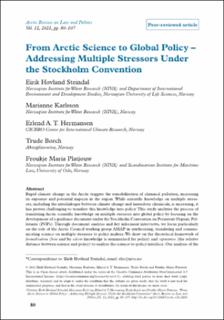| dc.contributor.author | Steindal, Eirik Hovland | |
| dc.contributor.author | Karlsson, Marianne | |
| dc.contributor.author | Hermansen, Erlend A T | |
| dc.contributor.author | Borch, Trude | |
| dc.contributor.author | Platjouw, Froukje Maria | |
| dc.date.accessioned | 2021-07-23T07:33:00Z | |
| dc.date.available | 2021-07-23T07:33:00Z | |
| dc.date.created | 2021-06-30T11:49:13Z | |
| dc.date.issued | 2021 | |
| dc.identifier.citation | Arctic Review on Law and Politics. 2021, 12, 80-107. | en_US |
| dc.identifier.issn | 1891-6252 | |
| dc.identifier.uri | https://hdl.handle.net/11250/2765158 | |
| dc.description.abstract | Rapid climate change in the Arctic triggers the remobilization of chemical pollution, increasing its exposure and potential impacts in the region. While scientific knowledge on multiple stressors, including the interlinkages between climate change and hazardous chemicals, is increasing, it has proven challenging to translate this knowledge into policy. This study analyzes the process of translating Arctic scientific knowledge on multiple stressors into global policy by focusing on the development of a guidance document under the Stockholm Convention on Persistent Organic Pollutants (POPs). Through document analysis and key informant interviews, we focus particularly on the role of the Arctic Council working group AMAP in synthesizing, translating and communicating science on multiple stressors to policy makers. We draw on the theoretical framework of formalization (how and by whom knowledge is summarized for policy) and separation (the relative distance between science and policy) to analyze the science-to-policy interface. Our analysis of the phases leading up to the guidance document show that AMAP has dynamically moved between different degrees of separation and formalization. Orchestrating the interplay between scientists and policy makers, the working group has put multiple stressors on the political agenda internationally. AMAP has thereby contributed to turn Arctic science into global policy through the guidance document. We conclude by illustrating several constraints in terms of the implementation of actual policy, which we argue is due to an increasing degree of formalization in the last phase and a general unreadiness of contemporary governance systems to address multiple stressors. | en_US |
| dc.language.iso | eng | en_US |
| dc.publisher | Cappelen Damm Akademisk | en_US |
| dc.rights | Navngivelse-Ikkekommersiell 4.0 Internasjonal | * |
| dc.rights.uri | http://creativecommons.org/licenses/by-nc/4.0/deed.no | * |
| dc.title | From Arctic Science to Global Policy – Addressing Multiple Stressors Under the Stockholm Convention | en_US |
| dc.type | Peer reviewed | en_US |
| dc.type | Journal article | en_US |
| dc.description.version | publishedVersion | en_US |
| dc.rights.holder | © 2021 Eirik Hovland Steindal, Marianne Karlsson, Erlend A. T. Hermansen, Trude Borch and Froukje Maria Platjouw | en_US |
| dc.source.pagenumber | 80-107 | en_US |
| dc.source.volume | 12 | en_US |
| dc.source.journal | Arctic Review on Law and Politics | en_US |
| dc.identifier.doi | 10.23865/arctic.v12.2681 | |
| dc.identifier.cristin | 1919535 | |
| dc.relation.project | Norges forskningsråd: 160016 | en_US |
| cristin.ispublished | true | |
| cristin.fulltext | original | |
| cristin.qualitycode | 1 | |

